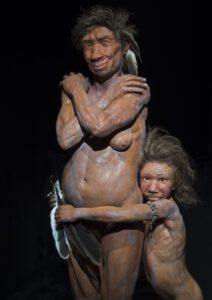In the article Neanderthals Were People Too, Jon Mooallem describes an electric moment where he felt a visceral connection to our long lost human cousins.
Watching a group of archeologist painstakingly excavate a small hearth in a cave in Gibraltar, Mooallen is suddenly struck by what he’s seeing. The bits of charcoal, the fire stained ground where embers are scattered and the smoke stained walls where the cinders from the fire had pushed up against the rock wall.
“Suddenly, it struck me — though it should have earlier — that what we were looking at were the remnants of a single event: a specific fire, on a specific night, made by specific Neanderthals. Maybe this won’t sound that profound, but it snapped that prehistoric abstraction into focus. This wasn’t just a “hearth,” I realized; it was a campfire.”
The Connection
He was looking at the remains of a fire that warmed these human cousins of ours on a night 50,000 years ago, and he felt connected.
Whether we feel it or not, most humans living today are connected to Neanderthals.
All non-Africans have between one and three percent Neanderthal DNA, a remnant of interbreeding as modern humans migrated out of Africa and met Neanderthals for the first time. And we likely carry remnants of other hominids in our DNA, such as the Denisovans.
Perhaps it’s that genetic connection that fuels our fascination with Neanderthal, or maybe it’s that what we learn is informing us all more about what it means to be human.
We know that we owe much to the Neanderthals. It’s likely that interbreeding with Neanderthals helped give humans an evolutionary advantage to adapt — beneficial immune response and blood clotting for instance — but it also left us with a subtle risk for certain diseases, according to research published early last year.
The Neanderthal Advantage
Vanderbilt University’s John Anthony Capra, was the lead author of that study, which we previously wrote about in the blog. Capra recently spoke with The New York Times about that research.
Over time humans purged all but the last vestiges of Neanderthal DNA — but some of what remains, even some of what previously could have been beneficial, is deleterious, according to Capra.
“What we’ve been finding is that Neanderthal DNA has a subtle influence on risk for disease,” Capra said.
For the research, Capra and his team looked at electronic health records from 50,000 individuals and found associations with Neanderthal DNA and immune response, blood clotting, and depression.
These findings and others indicate that Neanderthals were much more like us than we previously thought.
“We tend to think of them as dumb and brutish,” Capra said. “There’s no reason to believe that. Maybe those of us of European heritage should be thinking, “Let’s improve their standing in the popular imagination. They’re our ancestors, too.’”



